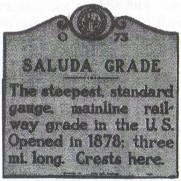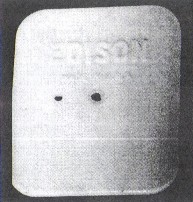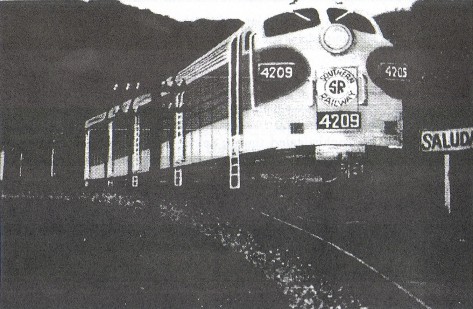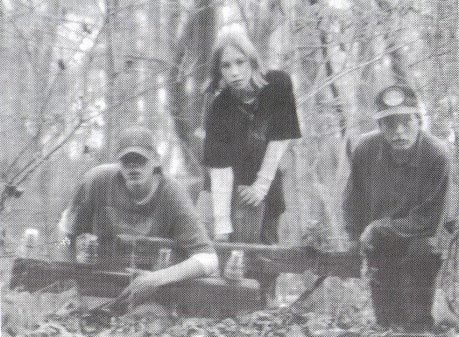Hunting on the Saluda Grade
by Gary Dexter
Reprinted from "Crown Jewels of the Wire", April 1997, page 17
With only a couple years of collecting under my belt, I am new to the
insulator hobby. During childhood, the aqua and amethyst-colored gems drew my
fascination as often as my aim. There was something very Christmas-like about
the poles with two or three loaded crossarms sparkling in the sun, their wires
often trailing a brightly-colored stray kite. My friends and I had reconciled
the variations in color to degrees of stress from dealing with the mysterious
and deadly force constantly passing through them. To these stalwart guardians of
our safety, BB guns were just a minor annoyance and an occupational hazard.
Being much thicker than the 6-1/2 oz. Coke bottles of those days, they rewarded
marksmanship with a just audible ping. We all shared a certain amount of awe for
them.

Somewhere on the road to middle age, insulators and many other childhood
wonders slipped from my consciousness and ceased to be thought of. I
rediscovered these jewels literally in my own backyard a couple of years ago. I
was shocked to notice they had all but disappeared from service. And that the
modem replacements were sterile, businesslike, logical and anything but festive.
My knowledge and collection of the glittering icons of my childhood memories
began to grow along with a great deal of luck and good fortune.
My backyard is
the Saluda Grade, the steepest main line standard gauge railroad grade in the
United States. It climbs over a thousand feet in just under three miles. It is
one of only two ways up the steep Blue Ridge escarpment by rail for hundreds of
miles.
Construction started just after the Civil War. The grade is cut shelf-like
into the face of the unstable shale mountains between Tryon, NC and Saluda, NC.
Meant only as a temporary link in the Spartanburg, SC to Asheville, NC road, it
is still in use today.
My son Shane, my nephew Steven and I have spent many days
traversing the rugged terrain around the right-of-way. We have discovered that
anything on or near the tracks eventually succumbs to gravity or landslides and
comes tumbling down only to be stopped by a tree of sufficient size. This
includes whole, sawed-off poles with cross arms, signal devices, battery jars,
banded bundles of cross ties, etc. We live about 300 feet below the low end of the grade. This affords us easy access to
this section of the grade.
Our first finds were aqua dome embossed CD 145
Brookfield beehives with address and patent dates, which we unscrewed from sawed-down poles. These jewels, though not rare, fanned the flames of our
insulator obsession. Very soon, sixty feet of our deck railing was sparkling
with various insulators lined up skirt-to-skirt.
With over fifty harrowing
curves and grades, from 3.7% to 5.9%. It is easy to understand the fear and
respect railmen have had for over 130 years for this section of track.
Slaughter-Pen Cut, Sand Cut and Horse Shoe Curve are aptly named and notorious
sites along the grade.
The first fatalities occurred during construction when a
locked box car carrying workers broke loose and careened down the mountain,
crashing and killing the five men trapped inside. The men were convicts from the
State Prison in Raleigh, which, at that time, contracted out prison labor for
many dangerous and disagreeable jobs. The accident did spur the General Assembly
to pass laws banning the use of prison labor. We have found five piles of old
lichen-encrusted rocks about 100 feet from the tracks. A local historian tells
us that the bodies of the unfortunate victims were buried there at the crash
site. Through the years, runaway trains and other accidents have brought the
total to fifteen lives lost on the grade.
In addition to numerous CDs, we have
found quite a bit of porcelain. These uniparts have been found with Locke,
Thomas, Lapp and G .P. Co. markings in rich mahogany, butterscotch and speckled
brown tones. Other porcelain finds include rich-colored strains, as well as
brown Westinghouse and G.E. lightning arrestors.
We stay well clear of the
tracks at all times. As danger lurks in many forms. Switches are remotely
controlled from fifty miles away and are apt to open or close at any time. There
are narrow, deep cuts with fifty-foot vertical walls through which the tracks
pass, leaving little room for a body to stand. Numerous streams thunder down the
mountain and under the tracks, making it impossible to hear an approaching
train. Then, there is what we have dubbed, "The Machine From Hell."
This orange behemoth travels the track fussing over the rail bed. With three
separate control cabs, it contours the bed, removing excess gravel and dirt,
shooting it at machine gun velocity away from the bed. The shrill sirens,
electric beepers, flashing lights and deafening noise will send one fleeing with
his heart lodged in his throat. Shattered insulators found were at first
attributed to mischievous target practice. We know now that they are victims of
"The Machine From Hell."
Another equally fearsome monster is "The
Slasher." This large, rotary-bladed device is capable of reducing pole
butts and cross arms to confetti as it trims thick brambles and brush along the right-of-way.
Shortly after the turn of the century, an engineer who became permanently
disabled after leaping from a runaway train, hit on a great idea: safety tracks,
or what we call runaway train ramps. These steep spurs ran uphill and terminated
in a huge pile of sand. A switchman was always on duty with the switch thrown to
the safety track. He would not open it until an approaching train sounded the
requisite "all clear" signal on its whistle.
Nowadays, sophisticated
timing devices are installed at intervals along the grade. Should a train pass
one of these at speeds over 8 m.p.h., they automatically throw the switch to the
safety track. The safety tracks have seen much action over the years as
evidenced by the many wheels, axles and tons of coal scattered about.
One
exciting, but heartbreaking find has been the discovery of battery jars - all
broken. At one time, there were banks of these aquarium-sized jars and relays at
predetermined intervals. When no longer needed, they were shoved over the edge.
The clear glass jars were etched with the word "Edison." Though we
have not located a whole one, we have retrieved the white porcelain tops
embossed "Edison Made in USA", as well as the "guts" and
assorted switches and relays.

There are other pesky, but non-lethal obstacles to
collecting on the grade, such as poison ivy and kudzu, which form thick,
impenetrable barriers. In season, there are also numerous ticks which seem to
rain down and drive one to bad dreams at night. Navigating through the thick
growths of enormous cane-like briars requires a system of delicate pirouettes.
To foolishly pull or bull through them results in only loosing more flesh.
Adding insult to injury, are the deep, black layers of coal dust and cinders -
the accumulation of a hundred-plus years worth of coal use and hauling. Bon-Ami
is the cleaning medium of choice for our evening showers.
The Saluda Grade has
provided the "meat and potatoes" of our respective collections. In
addition to the CD 145 beehives, it has provided CD 112, 115, 121, 128, 154, 155
and 203 in varying colors, by different manufacturers. We have supplemented our
collections with purchases made at local antiques stores, flea markets and junk
shops, trying not to pay over $3 for any one find.
Those interested may access
facts and information on the railroad town of Saluda, NC on the World Wide Web
at http://www.saluda.com/

Original painting by Gary Dexter of a
"50's-era" diesel on the
grade.

Crossarms laying near tracks with CD 154's and 145's.
(Left to right) Nephew
Steven Harvey, son Shane
with the author Gary Dexter.
| 